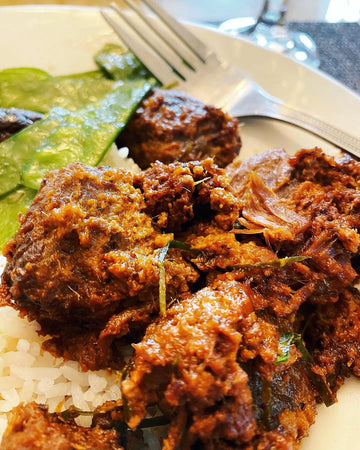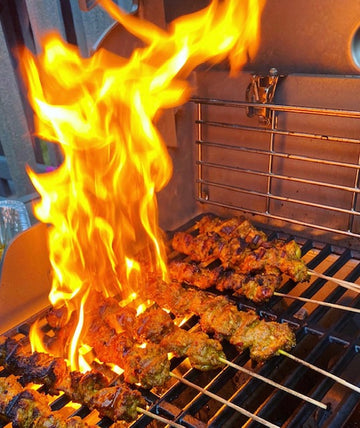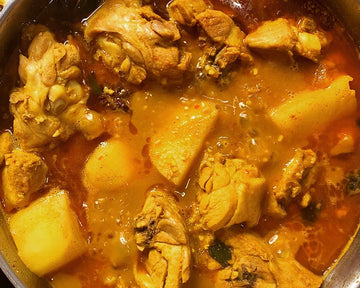So! You have a bag of delicately blended spices and aromatics for an authentic rendang. Now what? Sure, the bag gives you directions, but we were extremely limited by the available space on the pouch and couldn't give you all the details related to making a brilliant pot of rendang. Below are the finer points on how best to use this spice blend for the best at-home rendang experience possible.
Beef rendang is what my Mum usually made for special occasions and big parties. She didn't cook outdoors a lot, but rendang is the one dish she ALWAYS cooked outside, in a large wok set on a charcoal stove. To me, those outdoor rendang cooking days were always an adventure. When I was young, all I knew was that she combined a bunch of ingredients in the wok, fiddled with the fire to make sure it burned evenly for hours and the resulting dish of gloriously-flavored, melt-in-the-mouth beef was pure MAGIC. As I got older, she taught me how to watch over the rendang so she could take a nap in the early afternoon while it cooked - it was my job to keep watch of the fire, add charcoal, fan the flames, and most importantly, scrape the bottom of the wok regularly to make sure it didn't burn! Just before I left home to come to the US, she sat down and wrote out the recipe. Here's the method, in her own handwriting:

1. Rendang is most commonly made with beef or chicken. Other proteins that work well are pork, lamb or mutton. Unlike curries, rendang does not have potatoes or vegetables.
2. Cuts of beef that work well for rendang include brisket, beef cheeks, oxtails, ribs and boneless chuck stew meat. For chicken, I use a whole chicken cut into eight pieces - using all the parts of a chicken (bone-in and with skin) results in a tastier rendang, far better than just using one part of the chicken (breasts or thighs). For pork, I recommend a pork shoulder. Lamb and mutton - any cut that works in a slow-cooking recipe will do nicely. Use 2 - 4 lbs of protein per pouch.
3. Follow the package directions - mix the pouch contents, oil, coconut milk and water in a pot, bring to a boil, then turn down to simmer for ten minutes before adding your protein. When cooking with coconut milk, never let your pot come to a rolling boil. A rolling boil will split or break the coconut milk, resulting in a lumpy curry. As soon as the rendang gravy begins to bubble, turn it down to simmer.
4. Remember to add salt to taste - there is no salt in these pouches.
5. Cook low and slow, uncovered, until the meat is tender, remembering to come back and scrape the bottom of your wok or pot regularly. The scraping of the bottom of the wok is crucial!
6. The rendang will get more and more dry as time passes and the meat soaks up all that incredible flavor. Feel free to add half a cup of water now and then, as needed. I prefer to cook it medium low, stirring every 10 minutes or so, and not add any water at all so it gets nice and dry. Some folks prefer to have a lot of gravy, in which case, adding water is fine. In terms of doneness, especially with beef, you're looking for your meat to be super tender and really fall apart - this might take about 90 minutes to two hours. In the image below, you might be able to tell that those chunks of beef shred easily with just the fork.
7. Taste and adjust seasonings - I usually add salt, a touch of sugar, and since the spice blends are quite mild, I add a heaping tablespoon of Hot Chilli Sambal for the heat level that I like.
8. For extra credit, if you have them, add three finely julienned Makrut lime leaves to the rendang once it's done. This is completely optional as this ingredient is already included in the blend. It just adds a pop of green, and that fresh lime leaf aroma that's SO Southeast Asian!
9. For a vegetarian rendang, I use this pre-fried tofu product that's available at most Asian supermarkets. A healthier option would be to just get a block of extra firm tofu and cut that into pieces and add them to your pot AFTER the rendang spices have simmered for a good ten minutes. The tofu version is SO GOOD, I've done events where the non-vegetarians were chowing down heartily on the vegetarian entrée!
Here's an Instagram video showing how a pot of chicken rendang is made.

___________________________________________________
For those of you who've asked, click here for the Instant Pot method.






How many lbs of meat per pouch?
I love your stories.